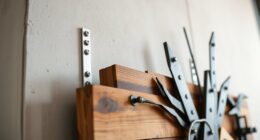To use Z-clips and panel clips securely, start by choosing compatible clips that fit your panel material and thickness. Prepare a clean, level surface and precisely mark your anchor points. Attach the Z-clips firmly with appropriate screws or anchors, ensuring proper alignment for even distribution. Test the fit and stability of each panel, adjusting the clips if necessary. Following these steps carefully helps guarantee a sturdy, long-lasting installation—you’ll discover even more tips as you continue.
Key Takeaways
- Select compatible clips designed for your panel material and thickness for a secure fit.
- Prepare a clean, level surface and precisely measure and mark anchor points before installation.
- Use appropriate screws or anchors, tightening just enough to secure panels without deformation.
- Test panel stability after installation and adjust or re-secure clips if movement is detected.
- Regularly inspect clip fit and panel position to maintain long-term durability and prevent shifting.

Securely installing Z-clips and panel clips is essential to guarantee your panels stay in place and function properly. When you’re working with mounting techniques, understanding how to properly secure these clips is crucial. The first step is to ensure that the clips you select are compatible with your panels and the mounting surface. Using compatible clips prevents issues like slipping, misalignment, or damage to your panels over time. Always check the manufacturer’s specifications to confirm clip compatibility, especially when dealing with different materials or panel thicknesses.
Your mounting techniques should start with preparing a clean, level surface. Proper surface prep helps ensure that the clips will sit flush and provide a secure hold. For Z-clips, it’s common to attach the mounting strip to the wall or frame using screws or anchors suited to the material—be it drywall, wood, or concrete. When installing, make sure the Z-clips are aligned precisely to avoid uneven panel placement. This alignment is critical because even a small misstep can cause panels to sit crooked or become loose later on.
Start with a clean, level surface for precise Z-clip installation and secure panel alignment.
Panel clips should fit snugly onto both the panels and the Z-clips or mounting surface. To achieve this, you might need to select clips with adjustable features or specific sizes matching your panels. It’s important to test the fit before final installation—if a clip feels loose or overly tight, it could compromise stability. Using the right mounting techniques involves tightening screws just enough to hold securely without exerting unnecessary pressure that could crack or deform the panels.
When installing multiple clips, spacing them evenly is vital. Improper spacing can cause uneven weight distribution, leading to stress points that might cause panels to warp or fall. Typically, clips are spaced 16 to 24 inches apart, depending on the panel material and size. Take your time measuring and marking anchor points to maintain consistency throughout the installation.
Additionally, considering the performance of your mounting setup can help prevent future issues, ensuring your panels remain securely in place over time. Once everything is in place, double-check the clip compatibility by testing the panels’ stability. Gently push or wiggle the panels to ensure they don’t shift. If you notice any movement, revisit your mounting techniques—tighten screws, adjust clip positions, or replace incompatible clips. Proper installation isn’t just about securing panels; it’s about ensuring long-term durability and aesthetic appeal. When you follow these guidelines for mounting techniques and clip compatibility, you’ll set up a secure, professional-looking panel installation that lasts.
Frequently Asked Questions
Can Z-Clips Be Reused Multiple Times Without Losing Strength?
Yes, Z-clips can often be reused multiple times without losing strength, but you should consider clip longevity and reuse considerations. Over time, repeated use may cause wear or deformation, reducing their holding power. To guarantee safety and secure mounting, inspect clips thoroughly before each reuse, looking for signs of damage or fatigue. Proper handling and avoiding excessive force during removal can help extend their lifespan and maintain their holding capacity.
Are Panel Clips Suitable for Outdoor or Humid Environments?
Imagine your outdoor space, rain gently falling on sturdy panels held by clips. Panel clips are generally suitable for outdoor or humid environments because they offer good moisture resistance and material durability. They’re designed to withstand exposure to the elements, preventing rust and corrosion. So, you can confidently use them outside, knowing they’ll keep your panels securely in place despite moisture or humidity, maintaining their strength over time.
What Tools Are Needed to Install Z-Clips Securely?
To install Z-clips securely, you’ll need a drill with the appropriate drill bits for your wall material. Use these drill bits to make precise holes for mounting screws, ensuring the clips are firmly attached. Select the right size of mounting screws for your surface and clips, then tighten them securely. This combination of tools guarantees your Z-clips stay in place, providing a stable support for your panels or artwork.
How Do I Remove Z-Clips Without Damaging the Panels?
Carefully, you begin panel removal, knowing one wrong move could cause clip damage. Gently pry the Z-clips or panel clips with a flat tool, applying even pressure to avoid bending or breaking them. Keep your movements slow and controlled, ensuring you don’t force anything. With patience, you’ll detach the clips without damage, revealing the panels beneath. Suspense fades as you successfully remove the clips, confident your panels remain intact.
Are There Weight Limitations for Panels Using Z-Clips and Clips?
Yes, there are weight limitations for panels using Z-clips and clips. Most Z-clip systems are designed with specific weight capacities to guarantee proper panel support. You should check the manufacturer’s specifications for the maximum weight your clips can hold, typically ranging from lightweight decorative panels to heavier, load-bearing surfaces. Staying within these limits helps prevent damage or failure, ensuring your panels stay securely in place.
Conclusion
Now that you know how to securely use Z-clips and panel clips, you’re ready to guarantee your panels stay in place. Just like a well-placed clip holds a panel steady, your careful installation keeps your project solid and reliable. It’s a simple step that makes a big difference—fastening things securely while maintaining a sleek look. So, don’t underestimate the power of the right clips; they’re the quiet heroes of your perfect finish.









